|
 |
 Автор: Williams Автор: Williams
 Дата: 13 октября 2018 Дата: 13 октября 2018
 Просмотров: 2 215 Просмотров: 2 215 |
| |
Schlumberger Virtual Materials Group VMGSim v10.0 build 04.2018
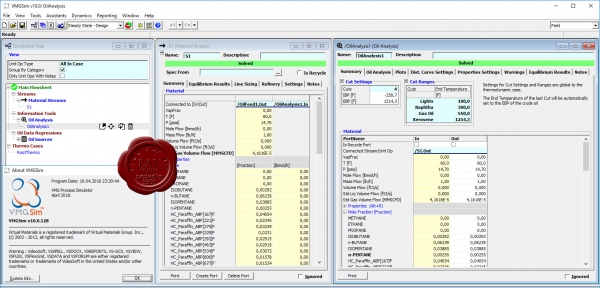
VMGSim is used around the world to model existing processes and to design new facilities from the ground up. With over 20,000 chemicals, more than 80 thermodynamic property packages and hundreds of unit operations, VMGSim provides unparalleled model sophistication and precision, giving you more time to solve processing challenges creatively. As a result, you'll find innovative ways to increase the value of your product while reducing your operating costs and wasted material. Let VMGSim be like your own engineering advisor: propagating information, anticipating your questions, and suggesting effective methods for model development and exploration. Better still, it builds your models based on rigorous thermodynamic relationships and needs only the information absolutely required to do so, saving you time and processing power.
Experiment with different equipment configurations in your simulation models to see the effects of changes to the whole system instantly and economically. VMGSim does this by instantly calculating process changes, intelligently propagating information, and continually monitoring degrees of freedom when you modify any unit operation parameters or process conditions.
Model your plants using a relatively small number of inputs because VMGSim can extract only the most useful information from your data. That information is then spread throughout your flowsheet automatically, allowing you to develop creative solutions to extremely difficult problems you may not be able to easily solve using traditional sequential simulators. VMGSim tracks all of your data inputs, making it possible to immediately see what was added to the system and the result. The bi-directional information propagation capability also eliminates the need for artificial recycle blocks and simultaneous convergence of recycles and controllers throughout your flowsheet.
VMGSim is a true Gibbs-based simulator that is capable of monitoring each variable’s state and its thermodynamic significance. By means of the Gibbs phase rule, with enough degrees of freedom fulfilled, calculations are automatically completed and the results transmitted throughout your flowsheet. Simulations are automatically recalculated every time you change the value of a variable without the need for special estimates. You can now concentrate on understanding your process while VMGSim handles the math. |
| |
 Читать статью дальше (комментариев - 9)
Читать статью дальше (комментариев - 9)
| |
|
 |
 Автор: Williams Автор: Williams
 Дата: 11 октября 2018 Дата: 11 октября 2018
 Просмотров: 440 Просмотров: 440 |
| |
SourceTec Sothink SWF Decompiler v7.4
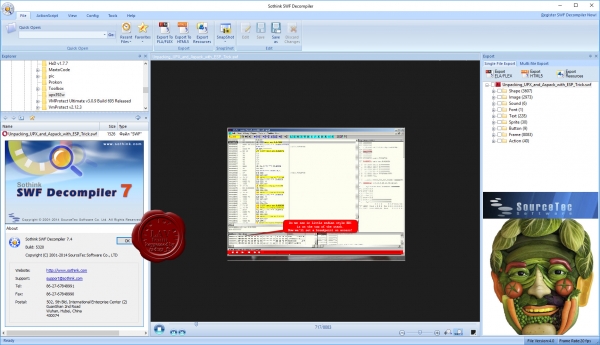
Sothink SWF Decompiler - прекрасный инструмент по конвертированию SWF в FLA. Загружайте, играйте и просматривайте Shockwave Flash видео (swf или exe). SWF Decompiler, полностью совместимый с ActionScript 2.0/3.0. Программа совместима со всеми SWF элементами, такими, как ActionScripts, звуки, изображения, видео, формы, рамки, точки, тексты, кнопки в различных форматах. Программа предназначения для извлечения различных ресурсов из Flash-клипов. Простой и понятный интерфейс, поддержка экспорта в .FLA-формат. Имеется удобный модуль для захвата Flash-клипов прямо из браузера.
Sothink SWF Decompiler is a professional tool to convert SWF to FLA fully and extract elements from SWF into variable formats. Compatible with all SWF versions and converted FLA is from version 6.0 to version 8.0. You can get the fully FLA file including linkage, components, *.as, etc. Also you can choose to extract ActionScripts as txt or bin, sounds as mp3 or wav, images as jpg or bmp or png, videos as flv, shapes as gls, frames/fonts/texts/buttons/sprites as swf to your local computer after an SWF is decompiled. Both SWF and EXE (Flash project) files are supported. Sothink SWF Decompiler provides a user-friendly interface. A built-in player enables you to preview the movie and every element before exporting. And you can customize the interface layout to meet your needs. To make SWF Decompiler even more appealing, SWF Catcher is offered freely. It is a free tool that can capture Flash movies you are viewing in the browser. |
| |
 Читать статью дальше (комментариев - 3)
Читать статью дальше (комментариев - 3)
| |
|
 |
 Автор: Williams Автор: Williams
 Дата: 10 октября 2018 Дата: 10 октября 2018
 Просмотров: 1 450 Просмотров: 1 450 |
| |
Advanced Conveyor Technologies Newton v2.60.00
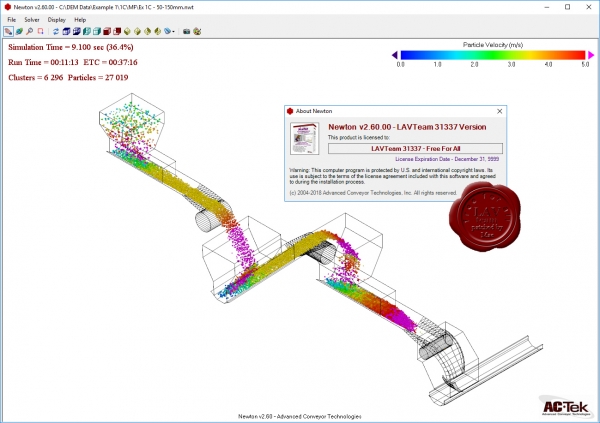
Newton is a general purpose Discrete Element Method (DEM) simulation package used to quickly and accurately model three-dimensional behavior of granular flow. A variety of constitutive models have been included to model a wide range of material properties including wet, sticky, cohesive material. Material degradation, surface wear, impact damage, energy dissipation, and other fundamental parameters can easily be analyzed. Newton is extremely flexible and can handle a wide variety of material properties and geometries including conveyor transfer chutes, apron feeders, chain feeders, bucket elevators, and more. It is developed and maintained by the engineering group at AC-Tek. |
| |
 Читать статью дальше (комментариев - 10)
Читать статью дальше (комментариев - 10)
| |
|
 |
 Автор: Williams Автор: Williams
 Дата: 9 октября 2018 Дата: 9 октября 2018
 Просмотров: 374 Просмотров: 374 |
| |
LizardSystems Terminal Services Manager v3.0.0.233
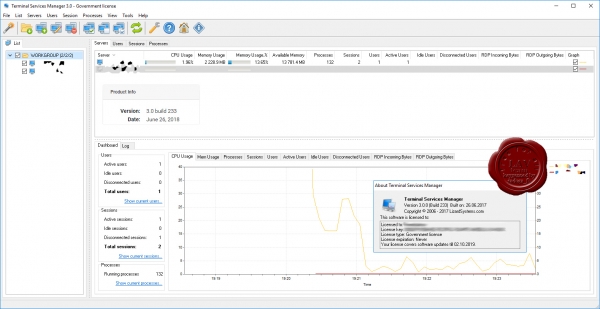
Terminal Services Manager shows which user is connected to the remote host, what processes they are running, and how much of the server resources (CPU and memory) they are using. You can send users messages, disconnect them from the server, or connect to their sessions remotely. With Terminal Services Manager you can send bulk messages to users, disconnect idle users, and end sessions of multiple disconnected users simultaneously. Terminal Services Manager allows you to work with several hosts at once. Terminal Services Manager displays information in both table form and by drawing graphs of the usage of CPU, memory, and other resources over time for each server, session, and user. |
| |
 Читать статью дальше (комментариев - 3)
Читать статью дальше (комментариев - 3)
| |
|
 |
 Автор: Williams Автор: Williams
 Дата: 8 октября 2018 Дата: 8 октября 2018
 Просмотров: 1 291 Просмотров: 1 291 |
| |
Криворуким и хитрожопым строителям юго-восточной хорды у платформы Плющево посвящвется ...
AvtodorPave v1.0
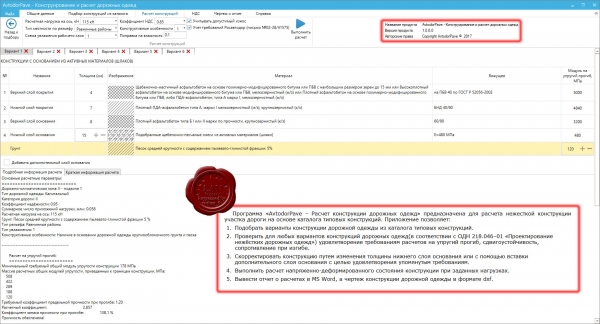
AvtodorPave - программный комплекс по конструированию и расчету дорожных одежд.
Основной функционал:
- Конструирование нежестких дорожных одежд в соответствии с требованиями СТО АВТОДОР 2.6-2013 «Требования к нежестким дорожным одеждам» и СТО АВТОДОР 2.25 -2016 «Каталог типовых конструкций»
- Расчет суммарного числа приложений расчетной нагрузки с учетом требований СТО АВТОДОР 2.25 -2016 «Каталог типовых конструкций» и СТО АВТОДОР 2.4-2013 «Оценка остаточного ресурса»
- Возможность анализа напряженно-деформированного состояния нежестких дорожных конструкций на основе точного решения теории упругости
- Вывод подробного отчета о результатах расчета и чертежей с вариантами конструкций дорожных одежд
|
| |
 Читать статью дальше (комментариев - 7)
Читать статью дальше (комментариев - 7)
| |
|
 |
 Автор: Williams Автор: Williams
 Дата: 7 октября 2018 Дата: 7 октября 2018
 Просмотров: 1 981 Просмотров: 1 981 |
| |
Split Engineering Split-Desktop v4.0.0.42 x64
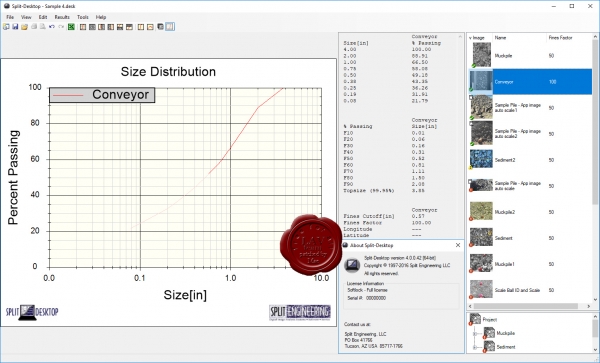
Split-Desktop is the industry approved software standard for manual, off-line coarse rock fragmentation size determination. More than 500 licenses have been sold in its 16 year history. Digital images acquired in the field can be analyzed on a laptop or at the office to determine the particle size distribution of your fragmented rock at any stage in the comminution process. The source of these images can be a muck pile, haul truck, leach pile, draw point, waste dump, stockpile, conveyor belt, rip rap, sediment or any other situation where clear images of rock fragments can be obtained. Within Split-Desktop, the images are manually scaled and edited for optimum accuracy. |
| |
 Читать статью дальше (комментариев - 11)
Читать статью дальше (комментариев - 11)
| |
|
 |
 Автор: Williams Автор: Williams
 Дата: 6 октября 2018 Дата: 6 октября 2018
 Просмотров: 1 459 Просмотров: 1 459 |
| |
LizardSystems Wi-Fi Scanner v4.2.0.167
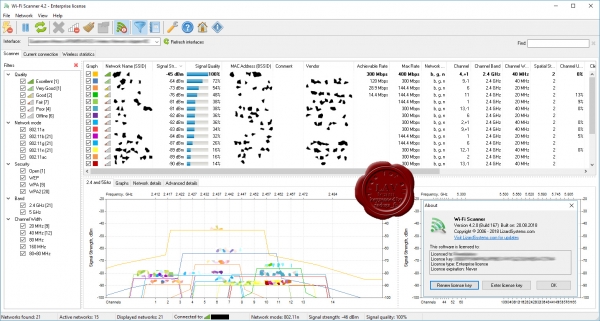
Wi-Fi Scanner allows you to easily locate visible wireless networks and its corresponding information. The tool obtains the network name (SSID), signal strength (RSSI) and quality, MAC address (BSSID), channel, maximum and achievable data rate, security, and much more. Wi-Fi Scanner is useful for normal access point users who need to find out the signal strength distribution for their wireless network at home, or choose a position for their access point for optimal signal quality. Using Wi-Fi Scanner, you can evaluate the allocation of wireless networks by channel and select the least congested bandwidth for their access point, allowing them to increase their connection speed significantly. In addition, Wi-Fi Scanner is an indispensable tool for corporate network administrators in performing tasks such as configuration, planning and monitoring security parameters on business wireless networks. |
| |
 Читать статью дальше (комментариев - 13)
Читать статью дальше (комментариев - 13)
| |
|
 |
| ПОИСК ПО САЙТУ |
 |
|
 |
| КАЛЕНДАРЬ | | |
 |
| « Октябрь 2025 » |
|---|
| Пн | Вт | Ср | Чт | Пт | Сб | Вс |
|---|
| | 1 | 2 | 3 | 4 | 5 | | 6 | 7 | 8 | 9 | 10 | 11 | 12 | | 13 | 14 | 15 | 16 | 17 | 18 | 19 | | 20 | 21 | 22 | 23 | 24 | 25 | 26 | | 27 | 28 | 29 | 30 | 31 | |
|
 | |
| |
|